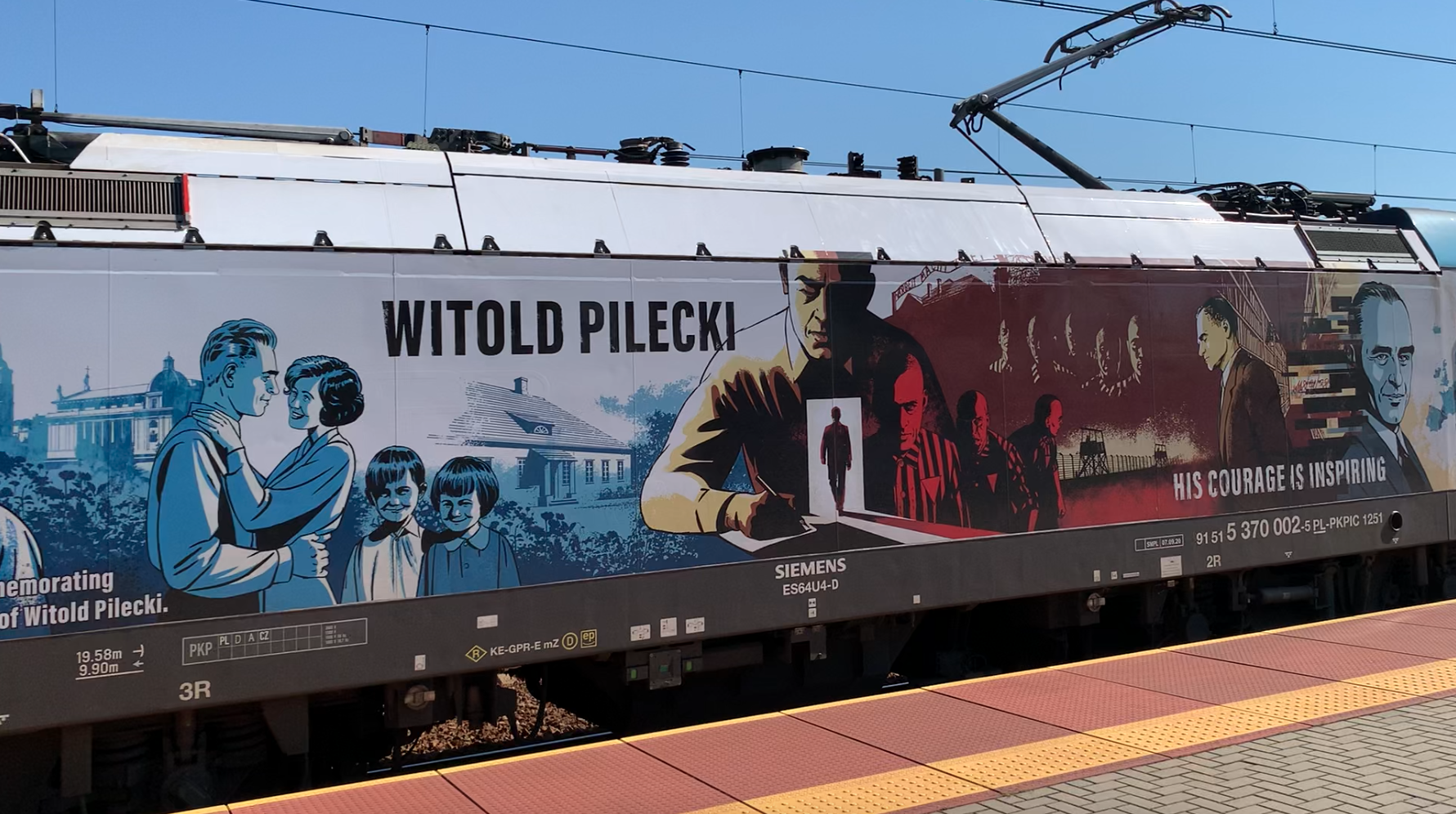Kraków 2022-08-13
Electric locomotive Siemens EU44-002 Husarz.
In August 2021, PKP InterCity introduced the Siemens EU44-002 Husarz locomotive onto the tracks with the graphic "Witold Pilecki". The graphic commemorates the 120th anniversary of the birth of Captain Witold Pilecki, a unique soldier in Polish history, who is a symbol of patriotism and heroism. Witold Pilecki was born on May 13, 1901. He was a participant in the Polish-Russian war of 1919 - 1920, and then a participant in the defensive war in September 1939, against the German and Russian plague. He was an officer of the Polish Underground State during the Second World War. He voluntarily allowed himself to be captured in a German round-up on the streets of Warsaw and ended up in the German concentration camp in Auschwitz to organize a resistance movement against German brutality there. After the war, Witold Pilecki was a conspirator who was building an intelligence network against the force of communion imposed on Poland. He was arrested and murdered by the communist authorities on May 25, 1948.



Electric locomotives EU44 Husarz.
EU44 Husarz is the Polish name of the EuroSprinter ES64U4 electric locomotive, which was produced by Siemens. In the 90s of the twentieth century, the idea was born to build a platform for universal electric locomotives, which can additionally operate on various electric tractions. This is how the EuroSprinter locomotive family was created, the serial production of which started in 2000. Since 2001, a universal two-system locomotive was produced, which was ordered by various European countries.
On September 2, 2006, an experimental EuroSprinter with a measuring car broke the speed record for conventional locomotives with 357 km / h.
Locomotives for Poland.
In August 2008, an agreement was signed for the purchase by PKP InterCity of 10 EuroSprinter ES64U4 Taurus locomotives. In Poland, the locomotives were designated EU44 Husarz.
In mid-November 2008, the first locomotive was presented at the Siemens factory in Linz. On December 18, 2008, the locomotive arrived in Warsaw for testing. On the night of May 28-29, 2009, during tests on the Central Railway Line, the locomotive broke the speed record for a train set consisting of a locomotive and carriages on Polish tracks, reaching a speed of 235 km / h.
In May 2009, the second locomotive arrived in Poland. On October 12, 2009, the first ride with passengers of the first EU44 Husarz locomotive took place on the Warsaw Grochów - Kutno route. In this section, the EU44 Husarz locomotive ran the Warszawa - Berlin - Express train station. The production of EU44 Husarz for Poland was carried out in the period 2008-2010. On June 21, 2010, the last tenth Husarz was delivered to Poland.
During the European Football Championship in 2012, the EU44 Husarz locomotives were covered with decals referring to the championship. Six locomotives ran in the colors of the countries participating in Euro 2012, and four in the colors of the Polish host cities. At the same time, 10 EP09 electric locomotives were glued in the colors of the other 10 countries participating in the competition.
The construction of the EU44 Husarz.
Siemens EuroSprinter ES64U4 (EU44 Husarz) is a standard-gauge universal multi-system electric locomotive (four-system). Bo'Bo 'axle system. The locomotive can work under the following traction: AC 15 kV 16.7 Hz, 25 kV 50 Hz, DC 3 kV, DC 1.5 kV. The locomotive classically has two cabins at the ends of the box. The middle part is the engine room, which is equipped with a corridor running through the middle. In the channel, under the floor of the corridor, there is a cable tunnel.
The locomotive has two two-axle bogies. The frame of the trolley is welded from steel profiles. The axles of the wheelsets rotate in a set of maintenance-free roller bearings up to the P5 maintenance level. The electric motor with the axis of the driving wheels is connected by a gear with skew teeth. Braking is performed by an additional brake shaft, which has two friction discs with jaws. The brake shaft is rotated by an additional toothed gear connected to the main toothed disc on the axis of the wheels. This solution is necessary due to the top speed of up to 250 km / h.
The drive system consists of four asynchronous motors powered by a pulse inverter with variable voltage and frequency. The motors have a power of 4 x 1,640 kW and the short-term power is 4 x 1,750 kW. The locomotive has a braking energy recovery system, the so-called recuperation. The locomotive has four pantographs arranged in pairs. Pantograph 1 and 4 receive energy from the AC network (type DAS 250.14) and pantograph 2 and 3 receive energy from the DC network (type DAS 250.11).
Data T-T EU44 Hussar:
Locomotive power depending on traction: 6,400 kW (AC), 6,000 kW (3 kV), 4,200 (1.5 kV). Maximum speed: 200 km / h (3 kV, 15 kV), 230 km / h (15 kV, 25 kV). Length: 19.6 m. Service weight 87,000 kg. Wheel diameter 1.15 m.
Written by Karol Placha Hetman
